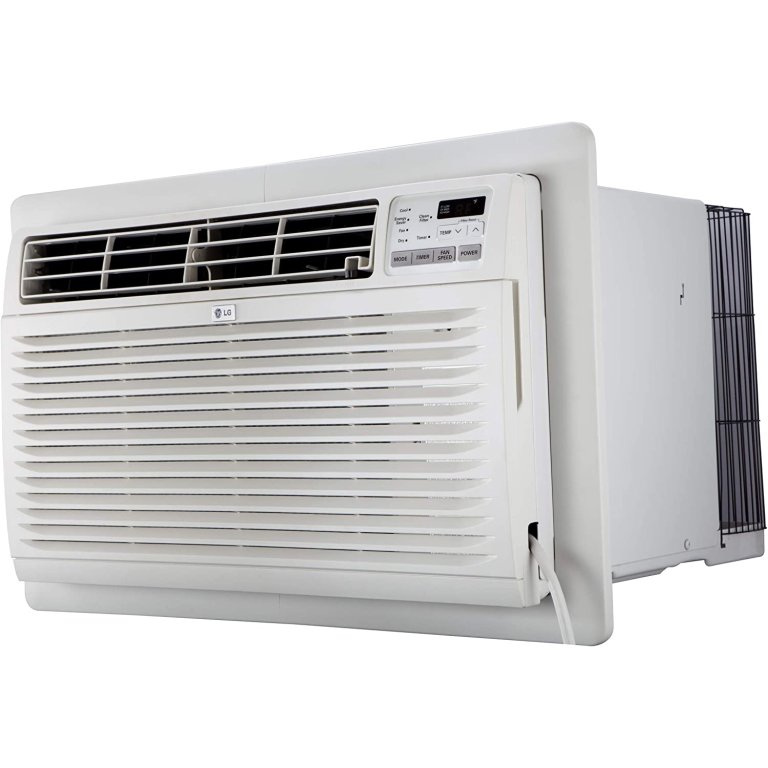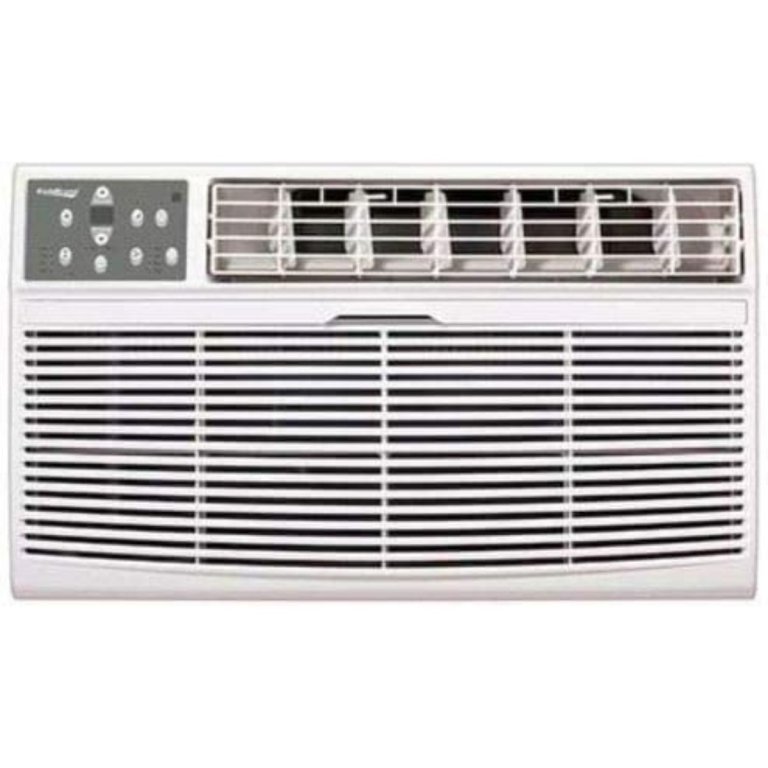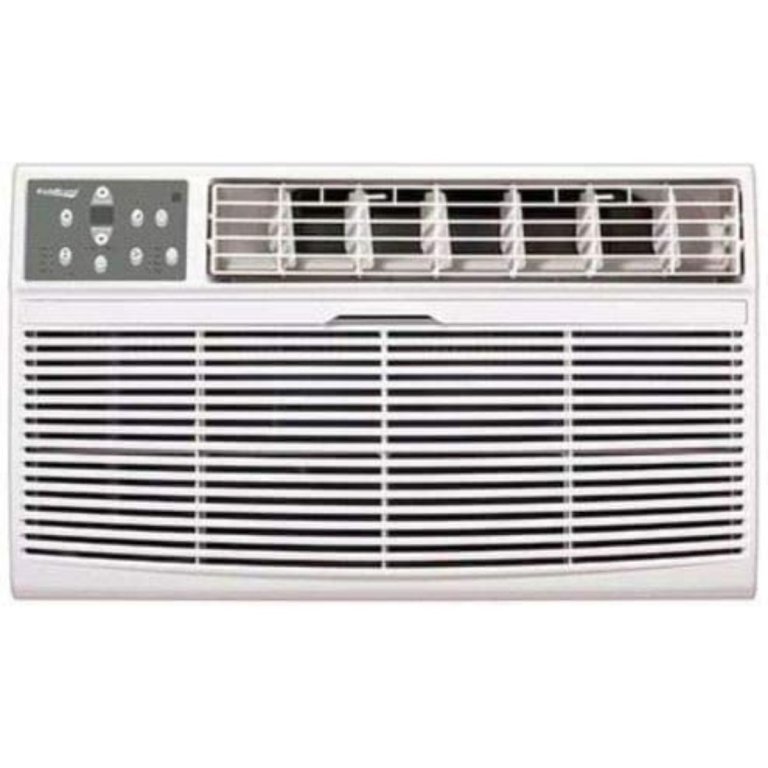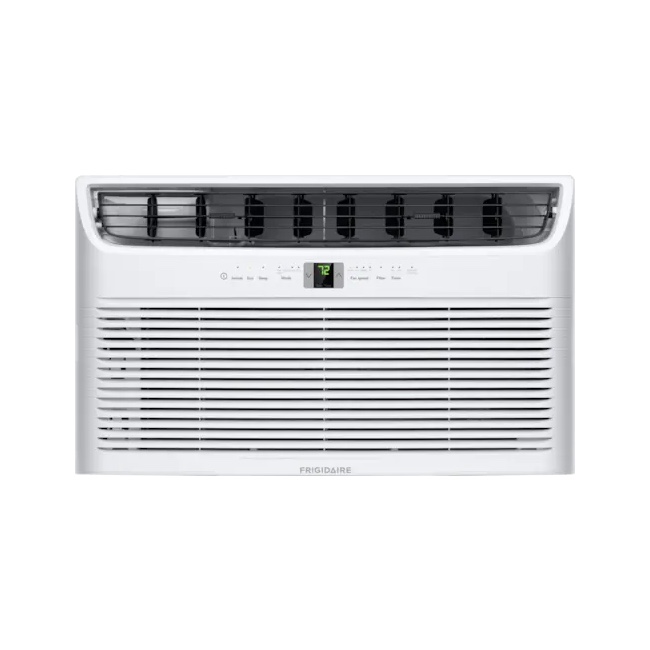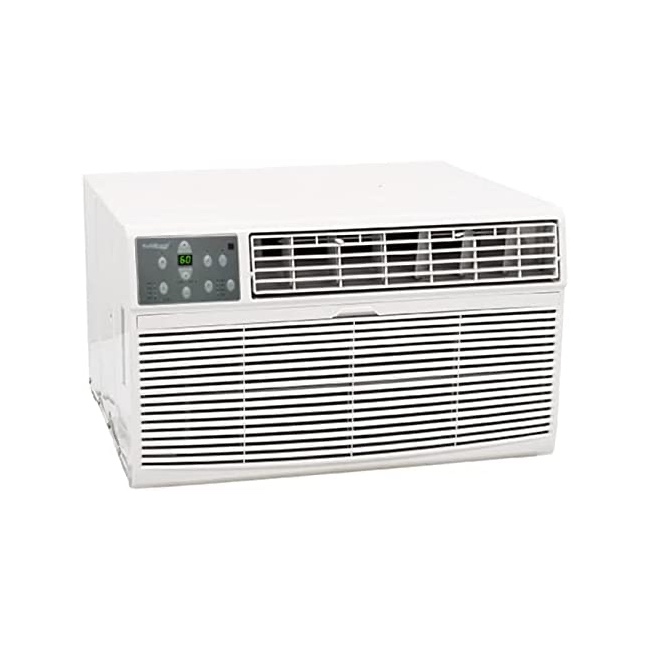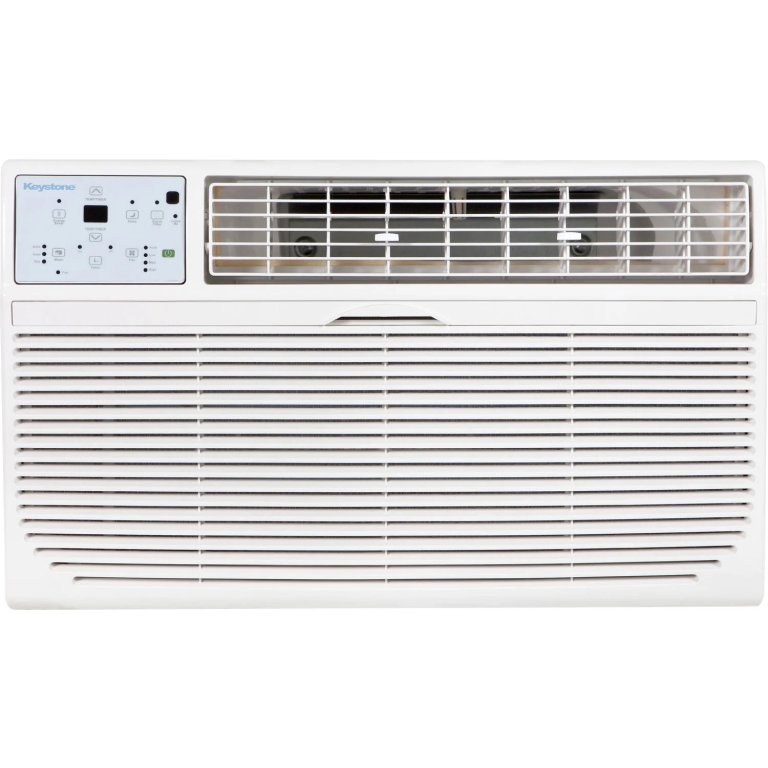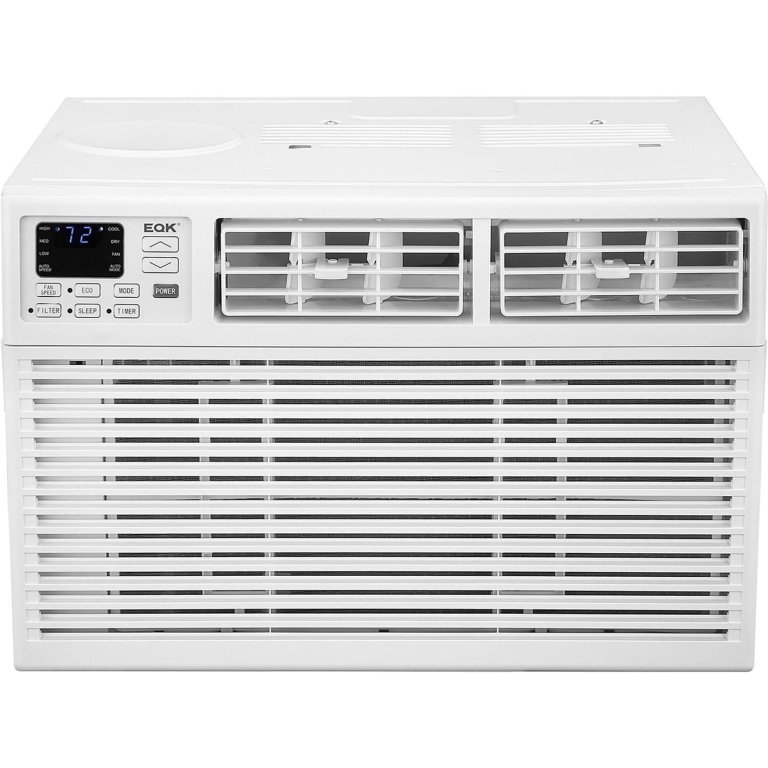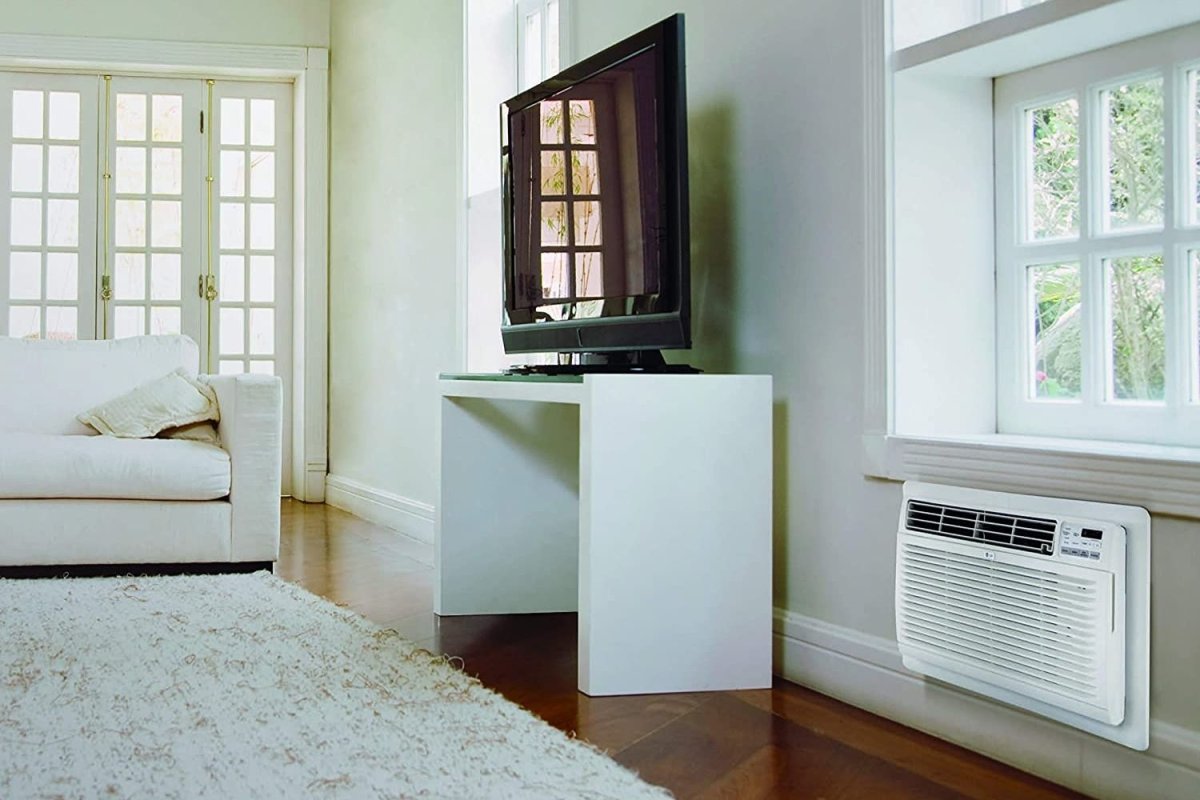
We may earn revenue from the products available on this page and participate in affiliate programs. Learn More ›
Through-the-wall air conditioners offer a viable alternative to traditional air-conditioning units that sacrifice a window—and the view that comes with it. These units function similarly to window air conditioners, but they fit into a hole in the wall, preserving the view and aesthetics of the room’s windows.
A through-the-wall air conditioner can produce up to 15,000 British thermal units (BTUs), making this type of air conditioner suitable for cooling rooms up to 700 square feet. Some models also include heating elements that supplement a home’s main heat source in the wintertime. We chose the LG LT1216CER Through-the-Wall Air Conditioner as our top pick due to its intense cooling power, energy efficiency, and adjustable louvers.
Our guide examines the crucial factors to consider when shopping for the best through-the-wall air conditioner and lists more of our recommendations for some of the best options on the market.
- BEST OVERALL: LG LT1216CER Through-the-Wall Air Conditioner
↓ Jump to Review - RUNNER-UP: Koldfront WTC12002WCO115V Air Conditioner
↓ Jump to Review - BEST BANG FOR THE BUCK: Koldfront WTC8002WCO 8,000 BTU Air Conditioner
↓ Jump to Review - BEST FOR LARGE ROOMS: Frigidaire FHTC142WA2 Built-In Room Air Conditioner
↓ Jump to Review - BEST WITH HEAT: Koldfront WTC12001W Air Conditioner With Heater
↓ Jump to Review - BEST FOR SMALL ROOMS: Keystone KSTAT10-2C Air Conditioner With Remote
↓ Jump to Review - ALSO CONSIDER: Emerson Quiet Kool Through-the-Wall Air Conditioner
↓ Jump to Review
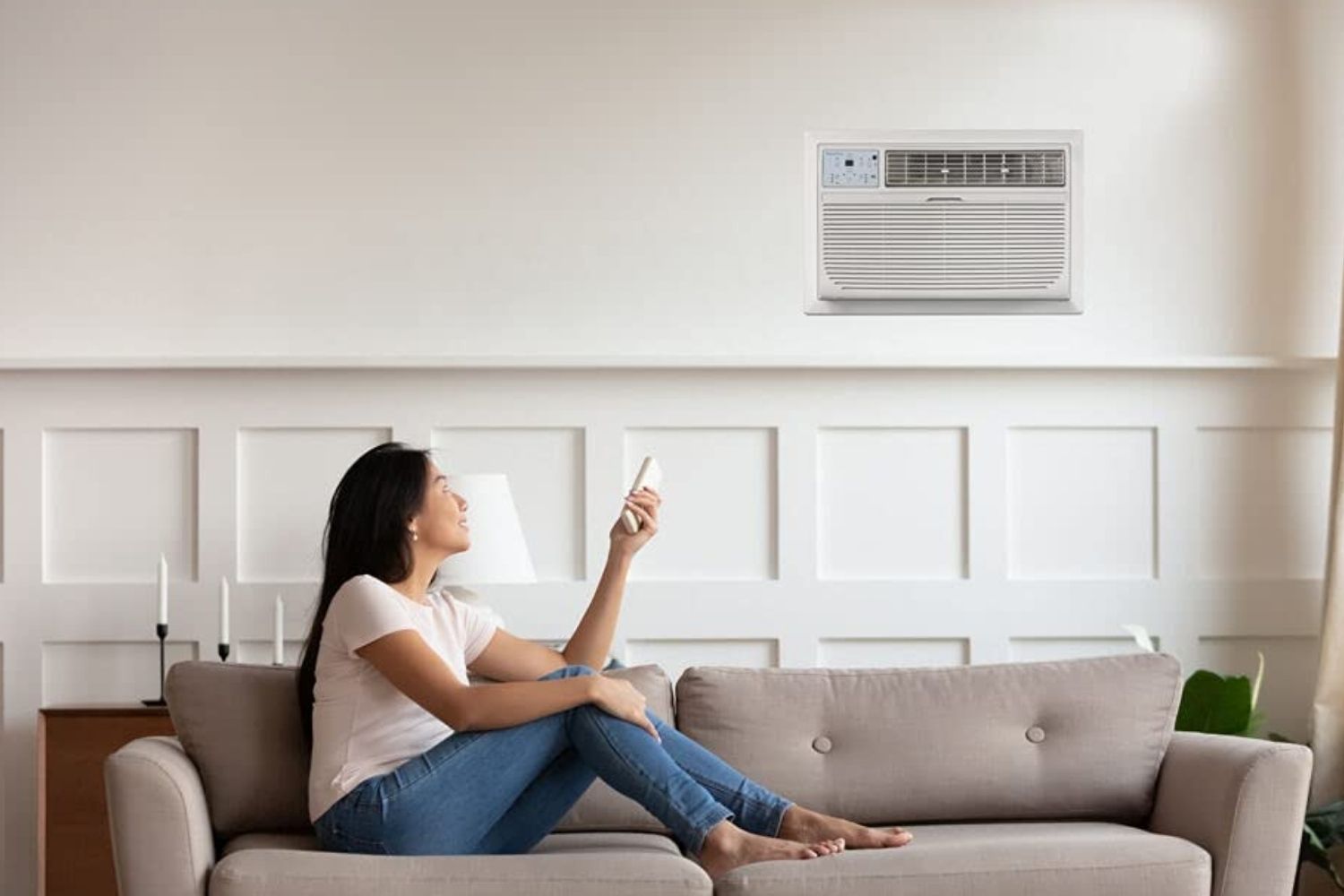
How We Chose the Best Through-the-Wall Air Conditioners
Lots of factors went into selecting the best through-the-wall air conditioners for this guide. We spent time looking at current technologies and products from all of the leading brands.
Cooling capability is obviously a key element, but performance is only one consideration. It was important to us to offer a wide variety of choices, so we included high-output models as well as smaller devices for those with more modest spaces to cool. Efficiency is another key factor and has a big impact on running costs. Noise levels were a key consideration. Plus, ease of installation played a part in our decisions, as did reliability and durability.
In addition to our own research, we collated information from other expert sources and from buyers who gave feedback on what these wall unit air conditioners are like to live with day-to-day.
Our Top Picks
The list below narrows the field to some of the best air conditioners on the market by coverage area. These products range from 8,000 BTU models for small rooms to 15,000 BTU behemoths for large spaces. They feature multiple operating modes and Energy Star certification.
Best Overall
LG LT1216CER Through-the-Wall Air Conditioner
See ItWhat We Like
- 3 fan speeds for rapid cooling; user-friendly remote control
- 3 modes, including dry mode, that can remove up to 3.9 pints of moisture per hour
- Energy Star certified; has a 24-hour timer to maximize efficient use
What We Don’t Like
- Although usually reliable, quality control may be inconsistent
Product Specs
- BTUs: 11,800
- Area: 530 square feet
- Energy efficiency ratio (EER): 10.6
A powerful output coupled with Energy Star certification make this model one of the best all-around through-the-wall air conditioners available. It produces 11,800 BTUs of energy, which is enough to cool up to 530 square feet. A robust set of operating functions allows you to select between optimal cooling power or energy efficiency with three cooling speeds and three operating modes: a turbo mode for quickly cooling a warm room, an energy-saver mode that cycles the compressor on and off, and a dry mode that removes humidity from the air. Adjustable louvers that blow in four different directions enable you to direct the airflow.
This air conditioner measures 14.41 inches high by 24 inches wide by 20.1 inches deep and includes a trim kit that creates a clean and finished look between the wall and air conditioner. It plugs into a standard 115-volt outlet.
Get the LG through-the-wall air conditioner at Amazon or Lowe’s.
Runner-Up
Koldfront WTC12002WCO115V Air Conditioner
See ItWhat We Like
- Good output and decent cooling area
- Multiple fan speeds and temperatures; dehumidification and timer
- Remote includes sleep and energy-saver functions
What We Don’t Like
- A few owners reported that their units stopped cooling within 12 months
Product Specs
- BTUs: 12,000
- Area: 550 square feet
- EER: 10.5
Cooling a larger living area in midsummer requires an air conditioner with some oomph. With an ample 12,000 BTUs of energy output, this model from Koldfront is well equipped to cool an area up to 550 square feet. It also includes a broad set of operational modes that allow you to fine-tune its performance, whether the goal is to save energy, maximize cooling power, reduce humidity, or create a comfortable environment for sleeping.
Keeping a large room cool when not in use just isn’t practical, which makes this model’s 24-hour auto-off timer so convenient. It allows you to set a time for the air conditioner to kick on so it’s cool before the occupants arrive home. A remote control makes it easy to cycle through the air conditioner’s modes, adjust fan speed, or change the temperature setting, while a cleanable filter removes impurities from the air. This air conditioner plugs into a 115-volt outlet.
Get the Koldfront WTC12002WCO115V through-the-wall air conditioner at Amazon, The Home Depot, or Walmart.
Best Bang For The Buck
Koldfront WTC8002WCO 8,000-BTU Air Conditioner
See ItWhat We Like
- High-quality construction ensures warm exhaust air does not reenter room
- 3 fan speeds with remote control, plus dehumidifying
- Energy Star certification, competitive EER, and timer function
What We Don’t Like
- Faults are rare, but a few owners have found the unit to be loud
Product Specs
- BTUs: 8,000
- Area: 350 square feet
- EER: 10.6
With its 8,000 BTU output, this through-the-wall air conditioner from Koldfront can cool up to 350 square feet, making it ideal for bedrooms, offices, and other small rooms. A convenient remote allows you to control all of the air conditioner’s settings, adjust temperature, and turn the unit on and off from across the room.
Despite its smaller capacity, this is a versatile air conditioner with numerous settings and functions, including a dehumidifier setting that reduces the humidity in the room, a sleep mode for quieter operation, and a 24-hour timer. This air conditioner measures 14.5 inches high by 24.25 inches wide by 20.375 inches deep and uses a 115-volt outlet for power, eliminating the need for complicated hard wiring.
Get the Koldfront WTC8002WCO through-the-wall air conditioner at Amazon, The Home Depot, or Walmart.
Best For Large Rooms
Frigidaire FHTC142WA2 Built-In Room Air Conditioner
See ItWhat We Like
- Provides the high performance needed for large rooms
- Precise thermometer control
- Programmable timer plus sleep and eco modes help reduce energy consumption
- Built-in ionizer and easy-clean washable filter
What We Don’t Like
- A premium-priced model that does not have Energy Star certification
Product Specs
- BTUs: 14,000
- Area: 700 square feet
- EER: 9.5
With its 14,000 BTU energy output, this air conditioner from Frigidaire can cool up to 700 square feet. It includes other useful add-ons such as a thermostat in the remote control (a must for evenly cooling larger spaces) and standard features like a programmable timer, multiple fan speeds, a sleep mode, and an energy-saver mode. At 14.5 inches high by 24 inches wide by 21.5 inches deep, Frigidaire’s through-the-wall air conditioner is similar in size to other models.
Get the Frigidaire through-the-wall air conditioner at Amazon or Walmart.
Best With Heat
Koldfront WTC12001W Air Conditioner With Heater
See ItWhat We Like
- Effective cooling plus a powerful 10,600 BTU heater
- Easy-to-read digital display with touch controls
- Programmable timer
- Eco-friendly coolant has no bromine or chlorine; will not harm the ozone layer
What We Don’t Like
- This unit requires a 230-volt supply, which complicates installation
- No Energy Star certification
Product Specs
- BTUs: 12,000
- Area: 550 square feet
- EER: 9.5
If a room is warmer in the summertime than the rest of the house, then chances are it’s also colder in the wintertime. With its built-in heating function, this through-the-wall air conditioner from Koldfront can warm a chilly room during colder periods while keeping the space cool in the summer. Its 12,000 BTU cooling output and 10,600 BTU heater make it capable of cooling or warming rooms up to 550 square feet.
Useful operating modes such as energy saver, sleep, and dehumidifier add versatility to this air conditioner. Intuitive controls, which include a digital display on the unit and remote control, allow you to cycle through its modes, set the thermostat, or program on and off times with its 24-hour timer. This air conditioner measures 14.5 inches high by 25 inches wide by 21 inches deep and requires 230-volt power.
Get the Koldfront WTC12001W through-the-wall air conditioner at Amazon, The Home Depot, or Walmart.
Best For Small Rooms
Keystone KSTAT10-2C Air Conditioner With Remote
See ItWhat We Like
- Includes energy-saver mode
- Easy-clean mesh filter; Check Filter alert on unit
- Safety listing with Underwriters Laboratories
- LED display and electronic controls
What We Don’t Like
- Requires a 230-volt outlet, not a standard 115 volt
Product Specs
- BTUs: 10,000
- Area: 450 square feet
- EER: 10.6
If you’re searching for an air conditioner wall unit that can cool a small apartment, dorm room, or shed, be sure to check out the 10,000 BTU Keystone air conditioner. It accommodates rooms up to 450 square feet. This model not only cools but can also dehumidify up to 2.3 pints per hour. The unit features adjustable four-way airflow, three cooling speeds, three fans speeds, plus an Auto Cool function.
Perhaps the best part of this wall-mounted AC unit is its remote control. It has a built-in thermostat that can register the temperature of where users are located in the room and then adjust cooling power as needed. You can also program the 24-hour on/off timer to align with your schedule and, ultimately, save energy. The only drawback is that the unit requires a special 230-volt/20 amp electrical outlet, which may complicate installation.
Get the Keystone through-the-wall air conditioner at The Home Depot or Walmart.
Best Quiet
Emerson Quiet Kool Through-the-Wall Air Conditioner
See ItWhat We Like
- Energy Star rating; energy-efficient air conditioner
- Runs at only 52 decibels
- Includes remote control
- Intelligent Sleep Mode adjusts cooling output throughout the night
What We Don’t Like
- Requires assembly, which can be a bit tricky for some
Product Specs
- BTUs: 15,000
- Area: 700 square feet
- EER: 11.9
Air conditioning is a welcome luxury in the summertime—unless you and your guests have to raise your voices over the noise a particular unit is making. The Emerson Quiet Kool solves that problem. Not only does it boast 15,000 BTUs, but it runs at a quiet 52 decibels (a normal conversation clocks in at about 60 decibels).
Two air exhaust fans (as opposed to the typical one) work with three fan speeds to allow users to direct airflow in eight different directions. This wall-mounted air conditioner can remove up to 3.5 pints of moisture per hour to keep bedrooms, living rooms, or any other space within 700 square feet comfortable and cool. And if there’s ever a power outage, the Auto Restart triggers the unit to resume operation at its previous settings once the electricity comes back on. Its Energy Star rating and Eco function helps buyers save both money and energy.
Get the Emerson through-the-wall air conditioner at Amazon or AJ Madison.
Jump to Our Top Picks
What to Consider When Choosing a Through-the-Wall Air Conditioner
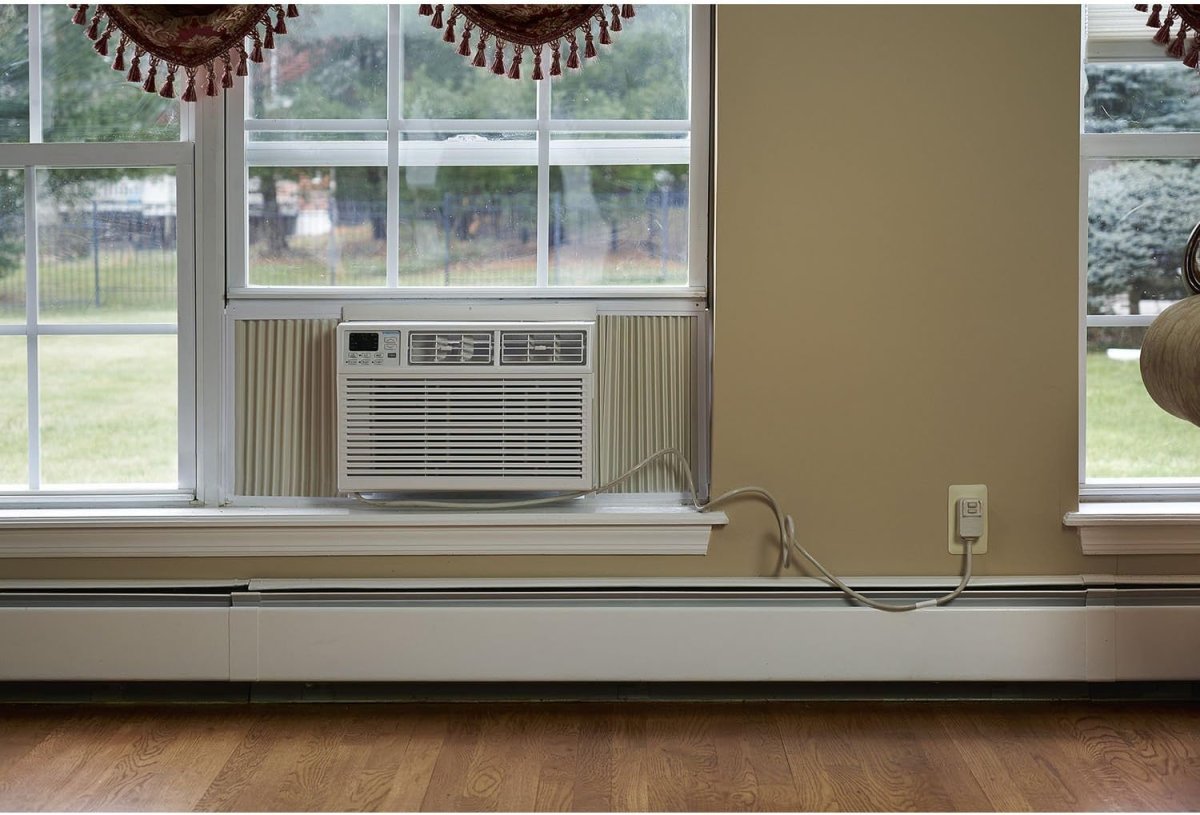
While selecting the right through-the-wall air conditioner to suit the size of the room is crucial, other factors are also important, including energy efficiency, operating modes, and whether the wall unit has a heating function. Below, learn more about these and other attributes of air conditioner wall units.
Location
Through-the-wall air conditioners are ideal for rooms that remain warmer than other parts of the home or that aren’t served by a central air conditioner’s ductwork. This could include a garage, a bedroom, or a bonus room.
While it’s possible to mount a wall air conditioner anywhere on an exterior wall, most units are mounted close to the floor so they are less conspicuous and don’t detract from a room’s aesthetics. When choosing a location, make sure there is enough space around the installation location on the exterior side to allow the air conditioner to draw air into the compressor.
Wall Thickness
Through-the-wall air conditioners are installed into a sleeve that fits into a hole in the wall. In order for the air conditioner to fit properly, the depth of the sleeve should be equal to or greater than the thickness of the wall. Most walls are about 5 to 7 inches thick, depending on the type of siding used on the home. Most air conditioner sleeves fit walls that are 8 inches thick or less.
Square Footage
Matching the size of the air-conditioning unit to the size of the room is crucial to selecting the right model. If the air conditioner is too small, it won’t be able to cool the space to the desired temperature. Purchasing an air conditioner that’s too large is overkill. The air conditioner will be more expensive than a smaller unit and cost more to run.
The best way to determine the right size air-conditioning unit is by matching the square footage in the room to the air conditioner’s energy output, which is measured in BTUs. Most wall air conditioners range in output between 8,000 and 18,000 BTUs. An 8,000 BTU air conditioner can cool up to 350 square feet, while an 18,000 BTU model cools up to 1,000 square feet.
While many through-the-wall air conditioners use a standard 115-volt outlet, some high-output models require a 230-volt connection, which can require special wiring.
Energy Efficiency
The more cooling power AC units mounted on the wall produce, the more electricity they use. An 18,000 BTU air conditioner uses more than twice the amount of electricity of an 8,000 BTU air conditioner. To compare energy efficiency between two wall air conditioners, simply calculate each unit’s energy efficiency ratio by dividing its watts by its BTUs to determine its Energy Efficiency Rating (EER). The higher the EER, the more efficient the air conditioner is. Most through-the-wall air conditioners have an EER rating between 9 and 11. Many manufacturers advertise the EER of their air conditioners.
Air-conditioning units with Energy Star certification must have an EER of at least 12. While Energy Star–certified units tend to cost more up front, they can quickly make up for that difference in energy savings. An Energy Star–certified wall air conditioner uses 15 to 30 percent less electricity than models that don’t have the certification (even with the same BTU output), making them cheaper to run.
Heating Function
Many through-the-wall air conditioners also offer a heat mode through a small built-in heating element. Air conditioners with heater functions that plug into a standard 115-volt outlet, as opposed to a 220-volt outlet, can produce around 5,100 BTUs of heat, which is enough for 144 square feet, while air conditioners that use a 230-volt connection can produce around 10,600 BTUs of heat, which is enough to heat a 500-square-foot space.
Keep in mind that the heating function is meant to supplement a furnace in the wintertime or provide a touch of warmth on a cool day. Through-the-wall air conditioners are not meant to serve as a main source of heat.
Additional Features
Many through-the-wall air conditioners have additional features that purify the air in a room, adjust the airflow, or allow you to customize its operation. A dehumidifier mode uses the air conditioner to reduce the humidity inside a room by running the fan on low mode and intermittently turning on the condenser. A fan-only mode circulates air throughout the room without using the condenser to cool the air, while a sleep mode runs the air conditioner at a quieter noise level while also slowly increasing the temperature through the night to accommodate for the natural decline in body temperature that happens during sleep.
Most wall air conditioners also have programmable 24-hour timers that automatically shut the air conditioner off after a set amount of time. Other features include louvers that allow you to adjust the direction of the air and air filters that clean the air by removing airborne contaminants such as pollen, dust, and mold spores.
Noise Level
Like window air conditioners, through-the-wall air conditioners include a compressor that creates the cool air and an air handler that blows air into the room using a large fan. This dual design tends to be noisier than central air conditioners, which feature a compressor that is outside the home and an air handler that is typically tucked away in an attic, or a ductless air conditioner, which has a compressor that is on the exterior home.
Since the air compressor is in close proximity to the living space, through-the-wall air conditioners are noisier, producing about 50 decibels, which is similar to light traffic or moderate rainfall. Some through-the-wall air conditioners feature quiet operation settings, which can drop the decibel level into the 30s. Keep in mind that when an air conditioner operates in quiet mode, it runs the compressor at a lower level, producing less cold air.
Aesthetic
Measuring around 20 inches high by 24 inches wide by 15 inches deep, a through-the-wall air conditioner is a sizable appliance. While these air conditioners are typically installed in an unobtrusive location, such as below a window, they are still a very visible feature in a room. So as not to detract from a room’s aesthetics, most models are white with understated features that include simple adjustable louvers that can direct airflow and a slatted vent that covers the filter and air intake. Some through-the-wall air conditioners include a trim kit that allows you to create a more finished look between the appliance and the wall.
FAQs
If you’re wondering how wall air conditioners differ from window air conditioners or which model to choose for your home, then read on for answers to some of the most commonly asked questions about these appliances.
No, they are not. Window and wall air conditioners are two distinctly different types of air conditioners. Both types of air conditioners draw air in from the outside and cool it before blowing it into the room, but there are important differences. A window air conditioner fits inside a window of the home, between the sash and sill. It isn’t suitable for all types of windows, and the window needs to be open (though sliding side panels fill any gaps). A through-the-wall air conditioner fits into a hole in an exterior wall so there’s no need to leave a window open.
There are a number of considerations when choosing an air conditioner for your wall, and these are discussed in detail in the article above. Room size has a major impact, so this is the starting point. Measure the square footage of the room so you know the size of the air conditioner that will cool that space. Also check your wall thickness and the installation requirements of models that meet your performance requirements. Finally, compare things like power consumption, controls, and any user-friendly features.
In terms of electricity supply, most through-the-wall air conditioners plug into a standard 115-volt outlet. However, larger models or those that provide heating may require more power, hence a 230-volt connection. This will usually involve running new wires from the breaker box; unless you have the required skills, it’s a good idea to call in a suitably qualified professional.
In terms of power consumption while running, it will depend on the model chosen. One way to judge is to look at the wattage. Higher numbers mean more power used. Air conditioners with Energy Star certification need to meet criteria set out by the U.S. government, so these are usually more efficient than nonrated models. Many manufacturers also provide an EER. Higher numbers are better.
A unit can last as long as 10 years if maintained properly. That means changing the air filter and examining the hoses. Naturally, if you live in a warm climate and run the air conditioner most of the year, it may not last as many years as, say, a unit being used in a climate with cold winter weather.
Wall-mounted air conditioners are not powerful enough to cool an entire home. Buyers will want to pay attention to manufacturer’s recommendations in terms of appropriate room size. Installation can be limited by a number of factors, including how much wall space is available, the material of the wall, and how close external walls will be to the unit once installed. They can also be difficult to access when changing filters or performing regular maintenance. You may require a ladder or stool.
Wall air conditioning units are designed to hold up to harsh weather conditions, so a cover is not necessary. However, if you live in an area of the country with excessive snow or freezing-cold temperatures for much of the winter, it can’t hurt to cover your AC unit to offer extra protection.
Match the size of the air-conditioning unit to the size of the room you wish to cool. Manufacturers provide this information for each of their units; it’s crucial to measure your space before selecting a model.



